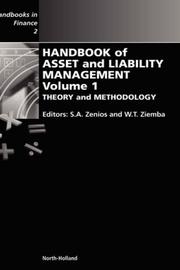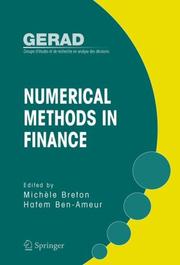| Listing 1 - 10 of 235 | << page >> |
Sort by
|
Dissertation
Year: 2017 Publisher: Liège Université de Liège (ULiège)
Abstract | Keywords | Export | Availability | Bookmark
 Loading...
Loading...Choose an application
- Reference Manager
- EndNote
- RefWorks (Direct export to RefWorks)
Le but de ce mémoire est de vérifier si l’allocation d’œuvres d’art (notamment grâce aux fonds d’art) dans un portefeuille traditionnel peut être bénéfique à l’investisseur. Les bénéfices peuvent découler de diverses sources : une augmentation du rendement, une diminution du risque, ou encore un meilleur ratio rendement/risque. Il est intéressant de savoir quelle proportion de son patrimoine un investisseur peut allouer à l’art sans que cette proportion ne soit trop importante afin de ne pas présenter un risque de liquidité. Pour ce faire, nous utiliserons le Sharpe ratio comme indicateur de performance et la théorie moderne du portefeuille mise au point par Markowitz (1952).
art --- diversification --- portfolio allocation --- crisis 2008 --- period 2000-2015 --- Sciences économiques & de gestion > Finance
Book
ISBN: 9034624048 9789034624048 Year: 1990 Volume: 71 71 Publisher: 's-Gravenhage : Centraal planbureau,
Abstract | Keywords | Export | Availability | Bookmark
 Loading...
Loading...Choose an application
- Reference Manager
- EndNote
- RefWorks (Direct export to RefWorks)
Economics --- Portfolio management --- Econometric models. --- AA / International- internationaal --- 305.91 --- Econometrie van de financiële activa. Portfolio allocation en management. CAPM. Bubbles. --- Econometrie van de financiële activa. Portfolio allocation en management. CAPM. Bubbles --- Portfolio management - Econometric models.
Book
ISBN: 9781906348359 Year: 2010 Publisher: London Risk Publications
Abstract | Keywords | Export | Availability | Bookmark
 Loading...
Loading...Choose an application
- Reference Manager
- EndNote
- RefWorks (Direct export to RefWorks)
AA / International- internationaal --- 339.40 --- 305.91 --- Vermogenbeheer. financiële analyse (algemeenheden). --- Econometrie van de financiële activa. Portfolio allocation en management. CAPM. Bubbles. --- Vermogenbeheer. financiële analyse (algemeenheden) --- Econometrie van de financiële activa. Portfolio allocation en management. CAPM. Bubbles

ISBN: 0444508759 9780444508751 Year: 2006 Publisher: Amsterdam Elsevier
Abstract | Keywords | Export | Availability | Bookmark
 Loading...
Loading...Choose an application
- Reference Manager
- EndNote
- RefWorks (Direct export to RefWorks)
Book
ISBN: 9781107177154 9781316630334 1107177154 1316630331 Year: 2019 Publisher: Cambridge: University of Cambridge,
Abstract | Keywords | Export | Availability | Bookmark
 Loading...
Loading...Choose an application
- Reference Manager
- EndNote
- RefWorks (Direct export to RefWorks)
This is a thorough exploration of the models and methods of financial econometrics by one of the world's leading financial econometricians and is for students in economics, finance, statistics, mathematics, and engineering who are interested in financial applications. Based on courses taught around the world, the up-to-date content covers developments in econometrics and finance over the last twenty years while ensuring a solid grounding in the fundamental principles of the field. Care has been taken to link theory and application to provide real-world context for students, worked exercises and empirical examples have also been included to make sure complicated concepts are solidly explained and understood.

ISBN: 0387251170 1441937730 9786610234189 1280234180 0387251189 9780387251172 Year: 2005 Volume: 9 Publisher: New York: Springer,
Abstract | Keywords | Export | Availability | Bookmark
 Loading...
Loading...Choose an application
- Reference Manager
- EndNote
- RefWorks (Direct export to RefWorks)
Book
ISBN: 1281795321 9786611795320 0080559964 0121500136 9780080559964 9780121500139 Year: 2008 Publisher: Burlington, MA ; London : Academic Press,
Abstract | Keywords | Export | Availability | Bookmark
 Loading...
Loading...Choose an application
- Reference Manager
- EndNote
- RefWorks (Direct export to RefWorks)
Calvet and Fisher present a powerful, new technique for volatility forecasting that draws on insights from the use of multifractals in the natural sciences and mathematics and provides a unified treatment of the use of multifractal techniques in finance. A large existing literature (e.g., Engle, 1982; Rossi, 1995) models volatility as an average of past shocks, possibly with a noise component. This approach often has difficulty capturing sharp discontinuities and large changes in financial volatility. Their research has shown the advantages of modelling volatility as subject to abrupt regime c
Book
ISBN: 9781420070354 9780429141898 9781138113664 1420070355 Year: 2011 Publisher: Boca Raton: CRC,
Abstract | Keywords | Export | Availability | Bookmark
 Loading...
Loading...Choose an application
- Reference Manager
- EndNote
- RefWorks (Direct export to RefWorks)
Book
ISBN: 9781906348144 1906348146 Year: 2008 Publisher: London: Risk Books,
Abstract | Keywords | Export | Availability | Bookmark
 Loading...
Loading...Choose an application
- Reference Manager
- EndNote
- RefWorks (Direct export to RefWorks)
Book
Year: 2011 Publisher: Washington, D.C., The World Bank,
Abstract | Keywords | Export | Availability | Bookmark
 Loading...
Loading...Choose an application
- Reference Manager
- EndNote
- RefWorks (Direct export to RefWorks)
Pension funds have been expected to invest in a wide range of securities and provide liquidity to domestic capital markets since they are the most sophisticated investors, with plenty of resources to gather private information and manage portfolios professionally. However, by analyzing unique, monthly asset-level data from the pioneer case of Chile, this paper shows that pension funds tend to herd. This is consistent with pension funds copying each other in their investment strategies as a way to extract information, boost returns, and reduce risk. The authors compute measures of herding across asset classes (equities, government bonds, and private sector bonds) and at different pension fund industry levels. The results show that pension funds herd more in assets for which they have less market information and when risk increases. Moreover, herding is more prevalent across funds that narrowly compete with each other, that is, when comparing funds of the same type across pension fund administrators. There is much less herding within pension fund administrators and across pension fund administrators as a whole. This herding pattern is consistent with incentives for managers to be close to industry benchmarks, which might be driven by both market forces and regulation.
| Listing 1 - 10 of 235 | << page >> |
Sort by
|

 Search
Search Feedback
Feedback About UniCat
About UniCat  Help
Help News
News